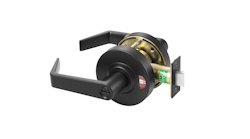For many years, there have been a few keys that are quite difficult to duplicate or originate. The problem involved getting the key/key blank located at the proper position within the vise jaw(s). These included the Chicago double-sided, a couple of cylindrical keys and some automotive keys. Even today, with the development of multi-position vise jaws, some of these keys and a few of the new ones are difficult to properly align.
To complicate matters, some aftermarket key blanks have different thicknesses, and the profile may vary slightly from the original.
In the early days, locksmiths would keep three or four different diameter paper clips secured to a magnet nearby the key machines. One of the different diameter paper clips would be placed along the groove in the key blank (and pattern key) blade that would be of the proper diameter to align it for cutting. If the paper clip was too thin or too thick, the key blank would usually not align.
This method would usually work well if the key being duplicated was not really worn. Most keys would have a “no cut” depth, which would enable the blade to be placed level. However, if the key was worn or there are no “no cut” depths, aligning the key became more of a problem.
For these keys, locksmiths used paper matches and a magnifying glass. The paper matches could be stripped to different thicknesses and used (sometimes with a paper clip) to level the pattern key in order to cut an operating duplicate key. The magnifying glass was occasionally used to visually make sure of the alignment in the vise jaw.
The paper match was also used to duplicate worn keys by lifting the pattern key several thousandths of an inch. This would occur when the first duplicate would be returned because the duplicated key would not operate the lock. The original would be raised several thousandths of an inch.
Cotter pins were used to hold and strengthen the Yale Y1, Sargent LN or any of the top level sectional keys that have thin cross sections, or any key that could possibly be deformed while being tightened in the vise jaw. Locksmiths kept on hand a variety of sizes of cotter pins. They would cut off the top and have two flat half-round pieces. These pieces would be placed against the blade in the thin areas to strengthen the blade in the vise jaw, preventing it from twisting.
On double-sided keys, locksmiths placed one of the cotter pins to fill the open space providing a flat surface towards the bottom of the key. Once the key blank has been cut on one side, they would flip over the key blank and use the cotter pin to keep the cut side aligned.
Important: When duplicating one of these keys, use one of the fillers for both the pattern key and the key blank.
Learning to cut keys using these tools was a real challenge. However, the alternative never seemed to be a good choice.
Over the years, many locksmiths became skilled at aligning keys/key blanks in the vise jaws in order to make operating duplicates or originals.
In the late 1970s, key adapters were introduced. A key adapter is designed to fit over a portion of the blade, improving the key positioning and clamping. The key adapter enables the key and key blank to align properly within the vise jaws. For key duplication; two key adapters are required, one for the pattern key and one for the key blank.
Ilco introduced the SCA-1 and SCA-2 key adapters for the Schlage wafer lock keys. The SCA-1 is an Ilco key adapter for the “U” wafer lock key, the Schlage 35-180. The Ilco EZ and Jet numbers are the SC6. The SCA-2, “W” key adapter is for the Schlage 35-200. The Ilco EZ and Jet numbers are the SC22.
The Ilco FOA-1 key adapters are designed for cutting the Ford H51 key blank. The adapter is reversible for cutting the H50 key blank.
RYTAN
Rytan , a manufacturer of locksmith products including key machines, manufacturers nine key adapters. The key adapters come two to a package. They are shown in Chart 1.
The key adapters are manufactured from billets of solid alloy stainless steel and are wire EDM to .0001” tolerance. The Rytan key adapters are a reverse image of the specific key blank section. They are designed to slide onto the blade of the key/key blank in order to hold it at the correct position.
Note: While the Rytan key blank adapters are designed for Rytan brand key machines, they should work with most key machines when using the standard key vise jaws.
For more information, contact your local locksmith wholesaler or:
Kaba Ilco at www.kaba-ilco.com
Rytan , Inc., at 455 Maple Avenue , Torrance , CA 90503 Telephone 800-447-9826 Web site: www.rytan.com
AABLE
Aable has introduced a key adapter for holding original “Z” keyway GM blanks or aftermarket blanks such as Ilco B106 or Jet B109-NP. These double-sided blanks are often difficult to hold in a duplicating machine, especially when cutting the second side.
The Aable adapter fits into the grooves of the “Z” blank and forms a solid vertical area for the vise jaws to clamp against. The adapters are designed to fit exactly into the key grooves of the “Z” blank and have the same bottom dimension as the uncut blank. For duplication, a pair of adapters is suggested. Insert one adapter against the original and one adapter against the uncut blank, then tighten both keys in the vise jaws.
After using the adapter while cutting the first side, the Aable adapter is inserted against the opposite side of the blank, again forming a bottom surface equal to the uncut blank. The Aable adapter and half-cut key can then be easily inserted parallel with the vise jaws and at the original cutting height.
Aable adapters can also be used on any code machine while originating a “Z” key by code. After making cuts on the first side, it is difficult to reposition the blank accurately while completing the second side. Some code machine manufacturers even recommend using a second blank and completing double-sided key making on a duplicator machine. Aable adapters positively hold the “Z” blank at the correct height when cutting both the first and second sides of the blank. This solves the problems of wasted key blanks and possible inaccuracies during key duplication.
Aable adapters are planned for other hard-to-hold keys. For more information, contact Frank Markisello at Aable Locksmiths, telephone 718-848-8000 or web site www.aablelocksmiths.com.





